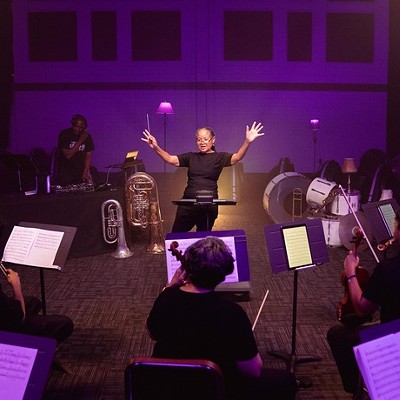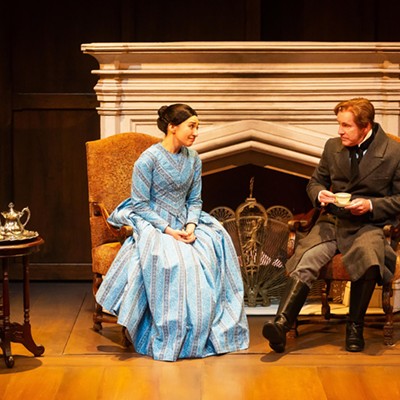The set-up: The heavens opened up Friday night during Opera in the Heights' galloping performance of Gaetano Donizetti's operatic masterpiece Lucia di Lammermoor (1835), appropriate for this Gothic romance full of ghosts, family dysfunction, vengeance, and omens foretelling disaster. But there was already lightning on stage. Full of dazzling radiance, soprano Jessica E. Jones lit up the intimate space as virginal Lucia driven mad by unrequited love. She supplied her own thunder and sparks to Donizetti's vocal fireworks. The execution: Lithe, with a full mane of auburn curls, Jones looked splendid in Dena Scheh's Restoration gowns and equally fetching in Lucia's bridal negligee, now spotted with the blood of her husband, whom she has just stabbed after her arranged marriage. You see, Lucia, heroine of Sir Walter Scott's 1819 "The Bride of Lammermoor." from which Donizetti's opera is loosely adapted, is the prototypical romantic heroine, buffeted by fate and the opportunistic maneuvering of her brother Enrico.
Although in love with her family rival, Edgardo, Lucia is browbeaten into marriage with the financially secure and much more socially prominent Arturo. She's unsteady at best during the opera's first two acts, seeing ghosts of her mother rise from the castle fountain, but Edgardo's sham betrayal (through a forged letter) sets her reeling in earnest.
In one of opera's most glorious "mad scenes," of which there are plenty on stage during the early 19th century, Lucia goes unhinged in the most aurally stunning way, running riot through scales and roulades of incomparable difficulty. Listen and watch how Jones dances through the flute arpeggios, played as in love by Wendy Bergin. Entranced, Jones smiles with the tunes, then matches them flawlessly, her coloratura always bright and shining clear. It's a wondrous duet, the epitome of bel canto technique of which this opera is a prime example.
Although baritone Octavio Moreno supplies a Mephistophelean overlay to mean brother Enrico with his plangent voice and solid acting, and Rubin Casas dives deeply into his stentorian bass to enliven the role of chaplain Raimondo, the rest of the cast didn't approach Jones in technique or stage presence.
Edgardo's role lies high and is treacherously difficult to pull off smoothly even with the best of singers, so we'll give an A for effort to tenor Anthony Webb. His voice is light and tightly wound with vibrato, and while he squarely hit all the notes, some were faint and just too lightweight for the fervency the role required. Big and burly, he sounded as if he were in another room just off stage. He wasn't the most ardent of suitors.
But perhaps the fault lies with director Carlos Conde, who seemed to be giving directions from another room, too. No one seemed to know what to do on stage, sitting down when they should stand, or haphazardly going up the stairs just to come down the other side, without dramatic rhyme or reason.
Sounding glorious, the chorus is clueless dramatically. What motivates these crazy, vengeful characters? Set within a church - supposedly, according to the program notes, to suggest the Anglican and Puritan divide which brought Oliver Cromwell to power in 1653 - well, this doesn't work at all.
This type of stage managing is much too fussy, and who the hell knows the intricacies of English history well enough to understand any of this? Donizetti certainly didn't, that's for sure. Where's the gloomy Ravenswood castle? There's no atmosphere here. Of course, Donizetti doesn't help either, especially at first, with his bouncy waltzes and rather peppy atmosphere that's supposed to conjure Scottish mist and long dead ancestors. He gets it together during Act II, and effectively brings it home in Act III with Lucia's mad scene and Edgardo's plaintive tomb scene. Finally, he moves into Verdi territory. You can actually hear where opera's future great master got his inspiration.
Donizetti knew all about madness. Ten years after Lucia, and after further international successes La fille du régiment and Don Pasquale, Donizetti would be ravaged by the effects of syphilis, dying in his beloved hometown Bergamo, Italy, in 1848. He had worn the mantle of Italy's greatest composer for a brief but shining time. Lucia, inventively melodic - the second act "Sextet" is one of the wonders of the world - is Donizetti in his most evocative and emotionally affecting mode.
The verdict: Maestro Enrique Carreón-Robledo keeps Donizetti hopping. Lucia sounds most alive, though, when Ms. Jones in on stage, singing her heart out, going mad and looking fabulous while she does.
Lucia di Lammermoor. April 3, 4, 5, 6m. Opera in the Heights, 1703 Heights Boulevard. Purchase tickets online or call 713-861-5303. $28-$55.






